
A Fresh Look at Nathan Myrick
(Written and researched by Jenny DeRocher, Archives staff. Edited by Tiffany Trimmer and Anita Taylor Doering. A special thanks to Henry Greengrass and Tracy Littlejohn for providing sources and counsel on this history.)
Living in La Crosse, you’ve likely heard Nathan Myrick cited as our community’s "founding father." Places like Spence Park and Myrick Park offer us the commemoration of Nathan Myrick and his trading post, but we forget to ask ourselves why we hold this narrative so close to our community’s identity.
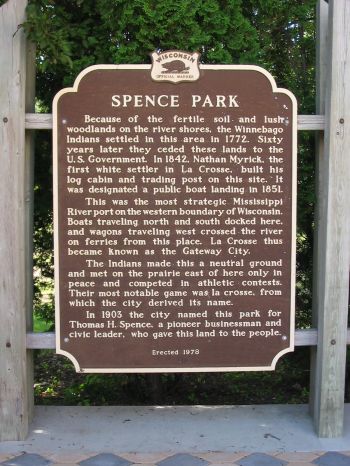
Photo retrieved from The Historical Marker Database. Photo taken by "Keith L." www.hmdb.org/m.asp?m=8538
The story of Nathan Myrick’s founding of La Crosse was recorded as early as 1854—just 13 years after he set up his business here in hopes of trading goods with the Ho-Chunk and other Indigenous peoples in the area. When Nathan arrived to the area we now call La Crosse in November of 1841, he and two other men named Eben Weld and James Reed built a cabin on Barron’s Island (where Pettibone Park is located).
While the river was still frozen in February 1842, they moved materials across the Mississippi using a team of horses they borrowed from Prairie du Chien and rebuilt their cabins and trading post (a total of three buildings) where the Charmant Hotel is today.

Nathan Myrick's trading post at the corner of Front and State streets.
In early 1842, Harmon J. B. “Scoots” Miller joined Nathan Myrick as a part-owner of the trading post. A year later, Nathan went home to New York and married Rebecca E. Isman, and the two travelled back here along with a friend of Rebecca’s named Louisa Pearson, who went on to marry Miller. Scoots and Louisa Miller went on to stay in La Crosse for many years, and are even credited for having the first white child to be born in La Crosse.
Many contemporary narratives of Nathan Myrick’s arrival leave out key details, like that he always had a business partner or two working with him, or that he was only 19-years-old when he arrived to La Crosse. Rebecca E. Isman Myrick is also typically left out of the narrative, though she likely played a key role in the management of the trading post and equally important domestic duties for the small community like gardening, farming, cooking, washing, and hosting travelers.
After a few years as a trader here, Nathan added to his operations a sawmill on the Black River. He often traveled to St. Paul and Prairie du Chien, buying land and networking. Then, in 1848, two important things happened that changed Nathan Myrick’s path: 1) a flood on the Black River destroyed his sawmill, and 2) the Federal Government invested in a more formal forced removal of the Ho-Chunk from Illinois, Iowa, and Wisconsin to a reservation near Long Prairie, MN.
In the green, you can see the boundaries of the Long Prairie reservation in Minnesota. Sauk Rapids is highlighted in yellow just southeast of the reservation borders. See full map here: portal.treatysigners.org/us/Maps/Minnesota_2.jpg
These two events were enough for Nathan to decide his profitable days in La Crosse were numbered. He had already spent years establishing partnerships with traders in Minnesota and was ready to move himself and Rebecca to their next location. He connected with a trader and capitalist named Asa White who he’d met here in La Crosse and followed Asa to establish a post in Sauk Rapids, MN. This post was just south of the Long Prairie reservation, to which the Ho-Chunk had forcibly been removed earlier that year. Nathan went on to establish 15 more trading posts across central and southern Minnesota, where he primarily followed the business of the Ho-Chunk and Dakota.
Though this sounds like a respectable business decision on the surface, in reality, it sheds light on how Nathan made his fortunes off the plight of the Ho-Chunk and Dakota. After treaties were signed and Indigenous communities like the Ho-Chunk were forced from their ancestral lands, they were set to receive yearly annuity payments from the federal government in compensation for their lands. When Indigenous folks needed more goods throughout the year than they could purchase from the annuity payments, they had to go to Government-approved traders. At the trading posts, they would be given credit to receive these goods. Traders then naturally had power in their relationship with their Indigenous customers, could choose whether or not to sell to certain individuals, and over-charge them at will.
Later, when it was time for the annuity payment, the local Indian Agent would first pay off the debts at the trading posts before giving the rest of the Government-owed annuity payments to the Indigenous individuals it was meant for. In this way, traders like Nathan Myrick and his business partners purposefully and knowingly profited from the suffering of the Ho-Chunk and Dakota. One of Nathan’s business partners was his younger brother Andrew, who is notorious for his role in the Dakota Uprising of 1862.

Andrew Myrick (left) and Nathan Myrick (right). The portrait of Andrew Myrick is from the Minnesota Historical Society.
Andrew Jackson Myrick was born in 1832, just two years after the Indian Removal Act was signed by President Andrew Jackson (who was clearly Andrew Myrick’s namesake). Andrew’s migration to the Iowa Territory (now Minnesota) is not as well documented as Nathan’s to La Crosse, but it’s clear that by 1862, Andrew and Nathan together owned a trading post on the two Dakota reservations that were in southwest Minnesota. By this point—30 years after the Indian Removal Act—the area was well populated by Euro-American immigrants and tensions were high in southern Minnesota as a result of treaties the federal government made with the Dakota and the Ho-Chunk.
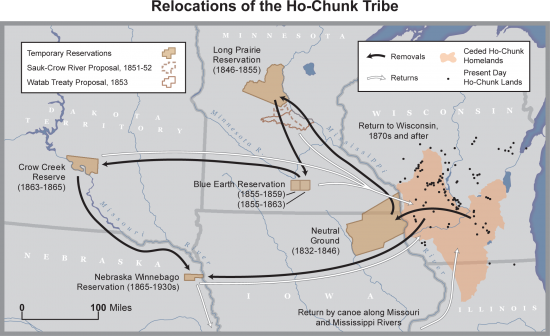
Map depicting the Federal Government's repeated forced removals of the Ho-Chunk, as well as their routes traveling back to the ancestral homelands. For more detailed information on the Long Prairie or Blue Earth reservations and removals, visit here and here. The map was created by Cole Sutton, colesutton11.wordpress.com
Seven years before the Uprising, in 1855, the U.S. government signed a treaty with the Ho-Chunk that moved them from the Long Prairie reservation to the Blue Earth reservation, which was on the ancestral lands of the Dakota. The Dakota had been just removed from this land in 1851, adding to the blossoming tension between the government, Euro-American farmers living on that land, and the Dakota. This tension would eventually lead to the 1862 Dakota Uprising. In 1859, the Ho-Chunk were forced to give up some of the land on the Blue Earth Reservation and signed a new treaty, at which Nathan Myrick and Asa White were both present and signed.
The 1862 Dakota Uprising has a nuanced and complex history and you can read more about that here. Historians all seem to agree that Andrew Myrick played a key role in the blossoming tension that came to a head. In his book Dakota Uprising Victims: Gravestones & Stories, Curtis A. Dahlin wrote:
“In early August, 1862, [Andrew] Myrick had refused to advance the starving Dakota credit so they could purchase goods. This refusal was prompted by the Dakota’s threat to prevent the traders from collecting previously incurred debts at the upcoming annuity payment. When [Andrew] Myrick was asked at this early August meeting what the Dakota should do, he stated, ‘So far as I am concerned, if they are hungry, let them eat grass.’ This remark of course greatly enraged the Dakota….His brother Nathan found his body on September 1, 1862... Andrew’s mouth was stuffed with grass and a scythe was driven through his body.” (page 25).
Though Nathan wasn’t present at the time of the Uprising, he could have been. According to Dahlin, he had just left for Fort Ridgely before the attack on his brother. In the duration of the war, all of Nathan Myrick’s Minnesota stores were destroyed. In the aftermath, the government confiscated annuity payments from the Dakota to partially reimburse Nathan $100,000 for his losses (in today's rates, that is nearly $3 million).
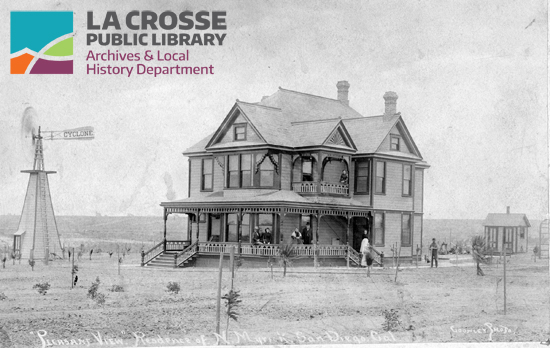
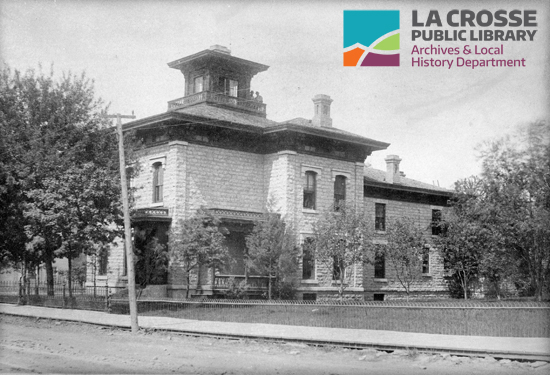
Nathan Myrick owned two large homes—one in San Diego, CA (top) as a part of a ranch and the other in St. Paul, MN (bottom)—indicating his massive wealth made from the exploitation of Indigenous communities.
Nathan retired in 1876. He often stayed in his St. Paul home and was able to stay in contact with locals looking to commemorate his role in the founding of La Crosse. He often wrote to the publishers of the La Crosse Chronicle, who would print his letters in the paper. In 1900, while visiting La Crosse, he even was interviewed and quoted in the paper:
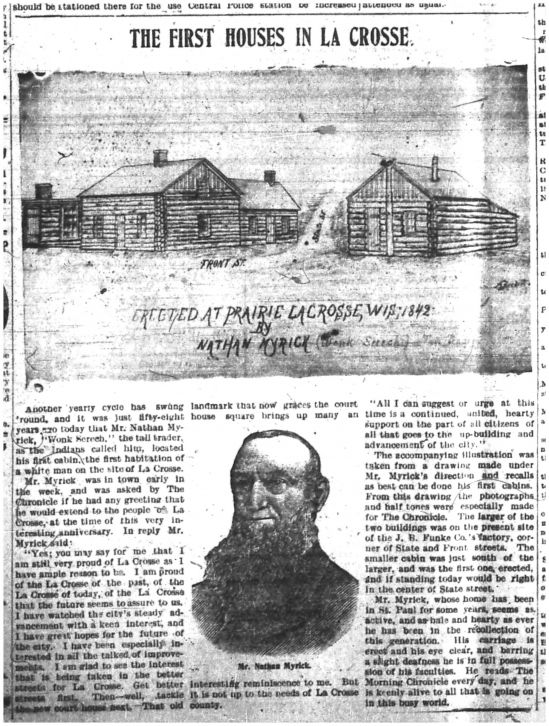
“The First Houses in La Crosse,” La Crosse Chronicle, August 3, 1900, page 5. Here is an image you can enlarge.
Nathan Myrick died in June 1903 in St. Paul. By this time, he had successfully written himself out of most narratives of the 1862 Dakota Uprising and into narratives that credited him as a founder or influential capitalist. Nathan continued to own land for many years in La Crosse, likely as a safety net if things didn't work out in Minnesota. Interestingly, when the area now known as Myrick Park was being improved and became a city-owned park, there was controversy locally over naming it after Myrick. Known originally by the name Lake Park, many residents expressed their opinion that Nathan Myrick didn't stay in La Crosse long enough to deserve the honor. But the anniversary of the city's founding celebration coupled with Nathan's death in 1903 probably propelled citizens to approve of the name change in 1904. Ironically, in Myrick Park are the remnants of effigy mounds constructed intentionally by the ancestors of the Ho-Chunk long ago.
